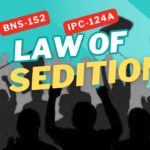Private defence (often called self-defence) is a core principle in Indian criminal law that lets individuals protect themselves and their property from unlawful attacks. Under the new Bharatiya Nyaya Sanhita (BNS) – India’s updated criminal code effective July 1, 2024 – the right of private defence is codified in Sections 34–44.
In simple terms, Section 34 of BNS states that “nothing is an offence which is done in the exercise of the right of private defence”. In other words, if a person reasonably believes they are in danger of death or grievous harm, they may use necessary force to protect themselves or others without criminal liability. BNS retained and refined the old IPC rules on self-defence: individuals still must face a real, imminent threat to trigger this right, and the force used must be proportionate to the danger. This balance ensures personal safety without encouraging excessive or vindictive violence.
The Bharatiya Nyaya Sanhita, 2023 is India’s official criminal code, replacing the Indian Penal Code (IPC) of 1860. It was passed by Parliament and came into effect on July 1, 2024. Chapter III of BNS covers “General Exceptions”, and specifically Sections 34 to 44 deal with the “Right of Private Defence”. Like the IPC before it, BNS explicitly protects the right to self-defence of body and property. In practice, this means that an otherwise punishable act (even causing death) is legally excused if it was the only way to repel a serious attack. For example, if a burglar breaks into your home and threatens your family, you may lawfully stop them (and even injure or kill them) as long as your response is reasonable and necessary. Conversely, one cannot claim private defence for minor disputes or after the danger has passed.
Legal Framework and BNS Context
- Legislative Change: The Bharatiya Nyaya Sanhita (BNS) 2023 was enacted to modernize India’s criminal laws. It replaces the IPC and took effect on July 1, 2024. All references below to sections (e.g. “Section 34 BNS”) refer to provisions in this new code.
- Chapter Structure: Chapter III of BNS (General Exceptions) includes Sections 34–44 under the heading “Right of Private Defence”. These sections mirror the old IPC Sections 96–106 but use updated language and examples.
- Scope of Right: BNS confirms that every person has the right to defend his own body or property, as well as the body or property of others, against certain criminal acts. This includes protection from attempts of theft, robbery, mischief or trespass against one’s movable or immovable property. For instance, if a mugger tries to snatch your purse, Section 35 BNS allows you to use reasonable force to stop the theft without facing punishment.

Key Provisions under BNS
The BNS sets out detailed rules on when and how private defence may be used. Key sections include:
- Section 34 (Private Defence): This fundamental provision states that “nothing is an offence which is done in the exercise of the right of private defence.”. In essence, any act performed in legitimate self-defence (reasonable, necessary force against an attacker) is excused.
- Section 35 (Right of Defence of Body & Property): Every person has the right (subject to Sec.37 limits) to defend their own or another’s body, and their own or another’s property, from criminal attacks. For example, if someone physically assaults you or attempts to rob your shop, Section 35 empowers you to use force to repel the attacker, including detaining them until police arrive.
- Section 36 (Defence against Insane or Intoxicated Aggressors): Even if the attacker is insane, mentally impaired, or intoxicated (and thus not fully criminally responsible), a victim still has the same right of private defence as if the attacker were sane. Illustration: If an intoxicated person brandishing a knife tries to kill A, the law treats A’s defensive response (even lethal force) as valid self-defence.
- Section 37 (Restrictions on the Right): There are clear limits to when private defence cannot be claimed. Notably:
- There is no right of private defence if the threatened act is non-serious (i.e. not causing reasonable fear of death or grievous hurt) and is carried out by a public servant acting in good faith under official duty. In other words, you cannot justifiably fight back against lawful police actions or minor official commands.
- There is also no right of private defence if the defender had time and safe opportunity to seek help from authorities instead of fighting back (e.g. calling police).
- Crucially, private defence never extends to excessive violence. Section 37(2) says you may not inflict more harm than is necessary for defence. In simple terms, the force used must be proportionate. For example, punching an unarmed thief to stop a robbery is allowed, but shooting them in the back as they flee would likely be excessive.
- Section 38 & 39 (Self-Defence of Body – Death vs. Non-Death): These sections explain when a defender may killan attacker versus only wound them:
- Deadly force permitted: Section 38 lists situations where causing death is lawful, such as if the assailant’s assault reasonably causes apprehension of death or grievous hurt, or is committed with intent to commit rape, unnatural sex, kidnapping, unlawful confinement, or throwing acid. For example, if someone attempts to sexually assault you, you may use deadly force in defence.
- Non-deadly force only: Section 39 states that if the attack does not meet those extreme conditions, the defender can use force but may not kill the assailant. In such cases only lesser harm is justified.
- Section 40 (When Defence of Body Starts/Ends): The right of self-defence commences as soon as a reasonable apprehension of danger arises (even before any injury occurs), and continues only as long as the danger persists. In practice, this means you may lawfully act at the first sign of a genuine threat, but once the attacker flees or is subdued, your right to use force ends.
- Section 41 & 42 (Self-Defence of Property – Death vs. Non-Death): Similarly for property defence:
- Deadly force permitted: Section 41 allows causing death to a wrongdoer if the crime is very serious – specifically robbery, night-time burglary (after sunset before sunrise), or mischief by fire to a dwelling. It also covers theft or trespass done under circumstances that make one fear death or grievous hurt if not defended. For instance, if an armed robber breaks into your home at night and attacks, Section 41 permits lethal defence.
- Non-deadly force only: Section 42 holds that for any other property offences (ordinary theft, petty trespass, etc.), the defender cannot kill the offender; only non-lethal force is allowed.
- Section 43 (When Defence of Property Starts/Ends): This section sets the timing for property defence. The right begins once danger to property becomes apparent and lasts only until either the offender retreats with the stolen property, the owner recovers it, or police arrive. For example, if a thief snatches a bicycle and runs off, you may pursue and use reasonable force to stop him – but once he drops the bike and flees, further violence would no longer be justified.
- Section 44 (Defence with Risk to Innocents): This allows a defender to act even if innocent bystanders might be harmed, in a life-threatening assault. Illustration: If A is besieged by a murderous mob containing innocent children, A may fire in self-defence. If a child is accidentally hit, A commits no offence (as explicitly illustrated in Section 44).
Conditions for Exercising Private Defence
Several conditions must be met before private defence can be lawfully used:
- Imminent and serious threat: The person exercising defence must reasonably fear death or grievous hurt from the assailant. Mere words or minor injuries do not justify deadly force. The assault or attempted crime must be serious enough (for example, a violent attack or a robbery) to create a genuine sense of life-threatening danger.
- No safe alternative: Private defence is only justified when there is no other safe option. If you have time to run away, call the police, or otherwise avoid the conflict, you should do so. Section 37(c) explicitly denies the right of defence if one could have resorted to authorities instead. In short: self-defence is a last resort when faced with immediate danger.
- Against unlawful force (not lawful acts): You cannot use private defence against a person lawfully acting. For instance, if a uniformed officer (acting within the scope of duty) orders you to disperse a crowd, resisting him would not be protected. Section 37(a)-(b) makes clear that no defence exists when the force is applied by a public servant in good faith. (However, if you genuinely do not know the attacker is an officer, the defence may still apply – see the example below.)
- Proportional force only: Any force used must be no more than what is necessary to repel the attack. This is often called the proportionality principle. For example, if someone slaps you, shooting them would clearly be disproportionate. If an attacker has a knife, disabling force is allowed, but continuing to beat them after they drop the knife is not. The law forbids excessive violence.
- Duration of right: The right to defend lasts only while the danger continues. Section 40 explains that once the threat is over (the attacker stops or flees), the defender must stop using force. Pursuing or inflicting harm beyond the point of neutralizing the threat is not covered by private defence.
In summary, private defence in BNS requires a real, immediate threat of serious harm, no safe way out, and strictly necessary response. These conditions ensure the right is not abused.
Judicial Interpretations
Indian courts have consistently emphasized that private defence is an exception to criminal liability and must be narrowly applied. It is assessed by asking whether the accused reasonably believed (on honest grounds) that danger was imminent and whether the force used was necessary. Scholars note that “the right to private defence is defensive in nature, aimed at protecting oneself or others rather than seeking retribution”. In practice, courts look at all facts from the defender’s perspective to decide if the fear was genuine.
Key judicial principles include:
- Reasonable Apprehension: The trigger for self-defence is reasonable apprehension of death or grievous hurt. A mere fear or suspicion is not enough; the defender’s belief must make sense to a hypothetical reasonable person. If an average person would not have felt seriously threatened, the defence fails.
- Duty to Retreat: While Indian law does not impose a strict duty to retreat (unlike some jurisdictions’ “castle doctrine”), courts recognize that if a safe retreat or police aid was clearly possible, claiming self-defence may be invalid. Simply put, if you could safely avoid the fight, taking extreme action becomes harder to justify.
- Proportional Response: Courts stress that any force beyond what is necessary nullifies the defence. As one legal guide observes, “the right of private defence does not extend to causing harm beyond what is necessary”. Thus, lethal force is scrutinized heavily; if non-lethal alternatives existed, causing death may be deemed murder.
- End of Threat: Once the danger passes, the right ends. This means, for example, that you cannot shoot a fleeing attacker in the back and still claim self-defence. Judges will look at whether the assailant posed an ongoing threat at the time force was used.
In effect, courts treat Sections 34–44 BNS as they did the old IPC provisions. They emphasize that self-defence must be genuine, immediate, and necessary. Any exaggeration (excessive injury, attacking after danger is gone) will typically result in conviction.
Case Examples and Illustrations
- Homeowner vs. Robber: Suppose X is awakened at night by a robber breaking in with a knife. Under Section 41, X’s defence may extend to causing death because robbery at night is listed as a qualifying offence. If the robber attacks X or X’s family, X can lawfully shoot the attacker even if it results in death. However, if the intruder simply tries to steal property without threatening life, deadly force would not be justified (non-lethal force only under Sec.42). This example shows how BNS distinguishes serious crimes (robbery, night burglary) from minor ones when allowing lethal self-defence.
- Street Theft vs. Saving Property: If Y sees a thief snatching her bag and running away, Y can run after and use reasonable force (like tackling him) to recover her belongings. But since simple theft (if it’s not in extreme circumstances) is not covered for deadly defence, Y cannot shoot the thief for running. This illustrates Section 42: ordinary theft or trespass allows only harm short of death.
- Insane Attacker: Z, who is mentally unsound, suddenly attacks A with a sharp object intending to kill (Z is not criminally liable due to insanity). Under Section 36, A still has the full right to self-defence as if Z were sane. So if A shoots Z to prevent being killed, it is lawful private defence even though Z has no criminal intent.
- Unknown Authority: Imagine a plainclothes police officer (unknown to B) starts beating B, and B doesn’t realize he’s an officer. B genuinely thinks he’s a criminal attacker. According to BNS (Sec.37 explanations), B’s right of defence is not lost if he didn’t know the assailant was a public servant. In that case, B may defend himself without penalty. This underscores that the law protects defenders who cannot identify an attacker’s official role.
- Defence with Innocents at Risk: The law explicitly anticipates tragic scenarios. For example, Section 44 gives an illustration: if A is attacked by a mob that includes innocent bystanders (like children), A may fire in self-defence. If a child is accidentally hit, A is not liable. This hard case example shows the law permits defending life even at some risk to innocents, reflecting the priority of saving the defender’s life.
These scenarios highlight BNS’s rules in practice. Each reinforces that private defence is fact-specific: courts will look at who attacked, how serious it was, and what the defender did in response.
Conclusion
The Bharatiya Nyaya Sanhita 2023 reaffirms and clarifies the right of private defence in India, maintaining the core idea that law does not punish necessary self-protection. For students and lay readers alike, the key takeaways are: private defence is allowed only against unlawful, serious threats; it must be reasonable and proportional; and it cannot exceed what the situation demands. The BNS sections 34–44 provide an explicit, detailed framework – from the basic rule (Sec.34) to special cases (unsound aggressors, defence with risk to innocents). In practice, anyone invoking self-defence must show they met the statutory tests (immediate danger, no safe retreat, necessary force). When properly applied, private defence serves its purpose of protecting individuals and society, without giving a license for undue violence. For further study, readers should compare these BNS provisions with earlier IPC law and follow emerging cases to see how courts interpret this right under the new code.
Sources: Analysis based on Sections 34–44 of the Bharatiya Nyaya Sanhita, 2023, official legislative summaries and expert commentary.


